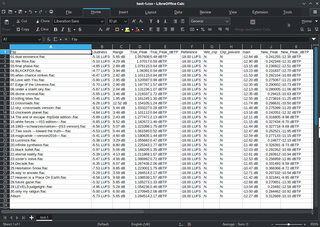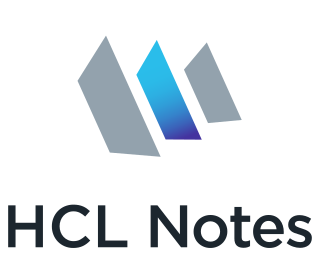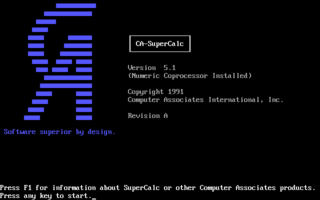
Daniel Singer Bricklin is an American businessman and engineer who is the co-creator, with Bob Frankston, of VisiCalc, the first spreadsheet program. He also founded Software Garden, Inc., of which he is currently president, and Trellix, which he left in 2004. He currently serves as the chief technology officer of Alpha Software.

Lotus 1-2-3 is a discontinued spreadsheet program from Lotus Software. It was the first killer application of the IBM PC, was hugely popular in the 1980s, and significantly contributed to the success of IBM PC-compatibles in the business market.

A spreadsheet is a computer application for computation, organization, analysis and storage of data in tabular form. Spreadsheets were developed as computerized analogs of paper accounting worksheets. The program operates on data entered in cells of a table. Each cell may contain either numeric or text data, or the results of formulas that automatically calculate and display a value based on the contents of other cells. The term spreadsheet may also refer to one such electronic document.

VisiCalc is the first spreadsheet computer program for personal computers, originally released for Apple II by VisiCorp on October 17, 1979. It is considered the killer application for the Apple II, turning the microcomputer from a hobby for computer enthusiasts into a serious business tool, and then prompting IBM to introduce the IBM PC two years later. More than 700,000 copies were sold in six years, and up to 1 million copies over its history.

HCL Notes is a proprietary collaborative software platform for Unix, Windows, Linux and macOS, sold by HCLTech. The client application is called Notes while the server component is branded HCL Domino.

SmartSuite is a discontinued office suite from Lotus Software. The company made versions of its office suite for IBM OS/2 and Microsoft Windows.

Mitchell David Kapor is an American entrepreneur best known for his work as an application developer in the early days of the personal computer software industry, later founding Lotus, where he was instrumental in developing the Lotus 1-2-3 spreadsheet. He left Lotus in 1986. In 1990 with John Perry Barlow and John Gilmore, he co-founded the Electronic Frontier Foundation, and served as its chairman until 1994. In 2003, Kapor became the founding chair of the Mozilla Foundation, creator of the open source web browser Firefox. Kapor has been an investor in the personal computing industry, and supporter of social causes via Kapor Capital and the Kapor Center. Kapor serves on the board of SMASH, a non-profit founded by his wife, Freada Kapor Klein, to help underrepresented scholars hone their STEM knowledge while building the networks and skills for careers in tech and the sciences.

Lotus Improv is a discontinued spreadsheet program from Lotus Development released in 1991 for the NeXTSTEP platform and then for Windows 3.1 in 1993. Development was put on hiatus in 1994 after slow sales on the Windows platform, and officially ended in April 1996 after Lotus was purchased by IBM.

Brad Templeton is a Canadian software developer, internet entrepreneur, online community pioneer, publisher of news, comedy, science fiction and e-books, writer, photographer, civil rights advocate, futurist, public speaker, educator and self-driving car consultant. He graduated from the University of Waterloo.

Visi On is a graphical user interface (GUI)-based operating environment program for IBM compatible personal computers running MS-DOS. Visi On was developed by VisiCorp. It was one of the first GUIs on a personal computer. Visi On was never popular, as it had steep minimum system requirements for its day, but it was influential in the development of later GUIs like Microsoft Windows.

VisiCorp was an early personal computer software publisher. Its most famous products were Microchess, Visi On and VisiCalc.

SuperCalc is a CP/M-80 spreadsheet application published by Sorcim in 1980.
Data Interchange Format (.dif) is a text file format used to import/export single spreadsheets between spreadsheet programs.

IBM Lotus Symphony is a discontinued suite of applications for creating, editing, and sharing text, spreadsheet, presentations, and other documents and browsing the World Wide Web. It was first distributed as commercial proprietary software, then as freeware, before IBM contributed the suite to the Apache Software Foundation in 2014 for inclusion in the free and open-source Apache OpenOffice software suite.
Sorcim Corporation was an early start-up company in Silicon Valley, founded in June 1980 by Richard Frank, Paul McQuesten, Martin Herbach, Anil Lakhwara, and Steve Jasik - all former Control Data Corporation employees working in the Language Group in Sunnyvale, CA. Jasik left company early on, to develop the MacNosy product for the Macintosh.
Productivity software is application software used for producing information. Its names arose from it increasing productivity, especially of individual office workers, from typists to knowledge workers, although its scope is now wider than that. Office suites, which brought word processing, spreadsheet, and relational database programs to the desktop in the 1980s, are the core example of productivity software. They revolutionized the office with the magnitude of the productivity increase they brought as compared with the pre-1980s office environments of typewriters, paper filing, and handwritten lists and ledgers. In the United States, some 78% of "middle-skill" occupations now require the use of productivity software. In the 2010s, productivity software has become even more consumerized than it already was, as computing becomes ever more integrated into daily personal life.
Concentric Data Systems, Inc. was founded in December 1979 by John J. Henderson and Jonathan Sachs, both having left their jobs as system programmers at Data General Corporation. Originally, the company undertook a variety of software consulting projects for the Data General line of computers. In 1981, the company developed a spreadsheet product, CompuCalc, that ran on Data General hardware and was modeled after VisiCalc.
Boeing Calc was a spreadsheet package written by Boeing Computer Services, an independent subsidiary of aviation manufacturer Boeing. It had originally been developed as an in-house accounting tool, but was launched as a commercial product in April 1985 for IBM 4300 mainframes running IBM MVS and IBM PC microcomputers running DOS. The original launch price was $399 per copy for the PC version and $8,899 for a combined PC/mainframe bundle.














